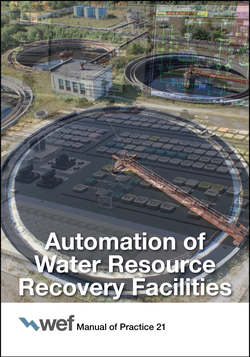Читать книгу Automation of Water Resource Recovery Facilities - Water Environment Federation - Страница 9
Preface
ОглавлениеThis Manual of Practice presents the elements of a complete automation design and the standards that govern those elements. The primary focus of the manual is to provide information to help designers of automation systems. However, this same information will be useful for utility managers and operators in understanding what information to expect from designers and how to interpret that information.
Several of the chapters from the 2006 edition of the manual were simply updated to current standards with some additions (e.g., Sensors), while several chapters were significantly shortened (e.g., Process Controllers) where excellent sources of outside materials could be referenced. Other chapters, however, were either added or greatly expanded to reflect technological changes. Chapter 7, Process Control Strategies, represents an update of the 1997 WEF manual titled Automated Process Control Strategies. Chapter 11, Communications and Connectivity, can be considered a tutorial on the topic and presents easy-to-read information about current products and alternatives. Chapter 12, Physical and Cyber Security, presents important topics for the design of any supervisory control and data acquisition system and discusses numerous guidelines from the Department of Homeland Security and others. Chapter 13, Human-Machine Interfaces, presents exciting new concepts in graphical interface design as well as recent International Society of Automation standards for alarming.
Automation is still a maturing component of the water industry. As such, technology improvements are constantly being developed and new applications are frequently being exploited to great benefit.
In addition to the WEF Task Force and Technical Practice Committee Control Group members, reviewers include Raman Saravanane, M.E., Ph.D. (Env. Engg), Grant Van Hemert, P.E., and Dave Weber, P.E.
Authors’ and reviewers’ efforts were supported by the following organizations:
Arthur Engineering, Inc., Elk Grove, California
Automation Consulting & Education, Inc., Tampa, Florida
Black & Veatch, Rancho Cordova, California
Brinjac Engineering Inc., Harrisburg, Pennsylvania
Brown and Caldwell, Maitland, Florida
Carollo Engineers, Inc., Littleton, Colorado
CH2M HILL, Columbus, Ohio, Redding, California, and Toronto, Ontario, Canada
City of Moberly, Missouri
City of Roseville, California
City of Toronto, Ontario, Canada
Columbia University, New York, New York
Donohue & Associates, Chesterfield, Missouri, and Sheboygan, Wisconsin
EB ENVIRONMENTAL, Houston, Texas
Ekologix Earth Friendly Solutions Inc., Waterloo, Ontario, Canada
EMA Canada, Inc., Oakville, Ontario, Canada,
EMA, Inc., Trevose, Pennsylvania, Sacramento, California, and St. Paul, Minnesota
Endress+Hauser Inc., Greenwood, Indiana
EnviroSim Associates Ltd, Hamilton, Ontario, Canada
GHD, Bowie, Maryland
Greeley and Hansen, Chicago, Illinois
Hach, Loveland, Colorado
Hazen and Sawyer, New York, New York
HDR Engineering, Inc., Cleveland, Ohio
HRSD Nansemond Treatment Plant, Suffolk, VirginiaInflection Point Solutions, LLC, Overland Park, Kansas
Johnson Controls, Inc., Westerville Ohio
Lagrange Consulting, Snellville, Georgia
Macon Water Authority, Macon, Georgia
Malcolm Pirnie | ARCADIS U.S., Inc., White Plains, New York and Phoenix, Arizona
modelEAU-Universite Laval, Quebec City, Canada
Parsons Corporation, Pasadena, California
Pondicherry Engineering College, Puducherry, India
San Jacinto River Authority, Conroe, Texas
Schneider Electric, Knightdale, North Carolina
Severn Trent Environmental Services, Fort Washington, Pennsylvania
SoftwareToolbox, Inc., Matthews, North Carolina
Stevens Institute of Technology, Hoboken, New Jersey
Toho Water Authority, Kissimmee, Florida
